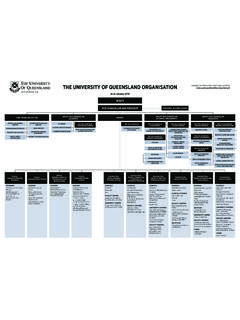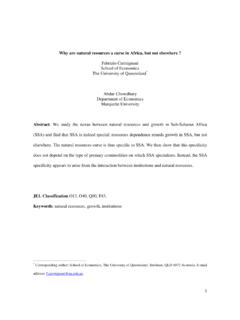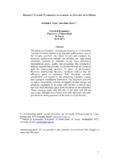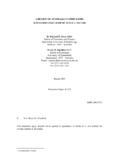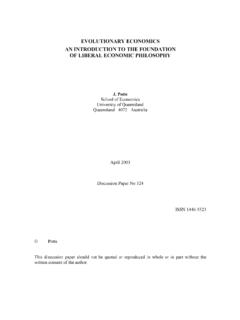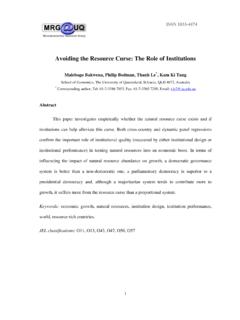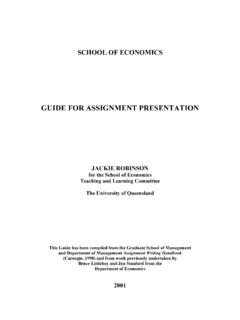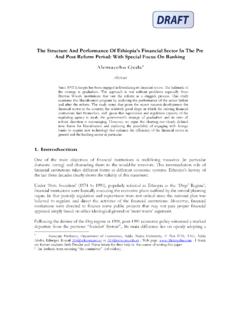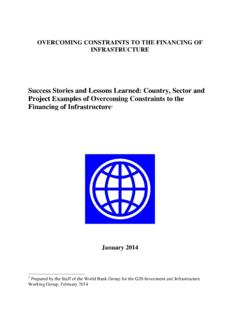Transcription of Energy Sector Reform, Economic Efficiency and …
1 1 Energy Sector Reform, Economic Efficiency and Poverty Reduction Tooraj Jamasb* Durham University Business School, Durham, UK Rabindra Nepal** School of Economics, University of Queensland, Australia Govinda Timilsina** The World Bank, Washington Michael Toman** The World Bank, Washington August 2014 Abstract It has been more than two decades since the widespread initiation of global Energy Sector reforms and restructuring. However, the empirical evidence on the microeconomic, macroeconomic and quality related performance of reforms across developing countries needs to be examined considering the sizable gap in the Energy economics literature. This paper reviews the empirical and theoretical literature on the linkages between Energy Sector reforms; Economic and technical Efficiency and poverty reduction.
2 The extent of reforms have varied across developing countries in terms of changes in market structures, the role of the state and the regulation of the Sector . Reforms have improved the Efficiency and productivity in the Sector among many reforming countries. However, the Efficiency gains have not always reached the end consumers due to the inability of Sector regulators and inadequate regulatory frameworks. Reforms seem to generate poverty alleviation impacts and promote welfare of the poor only when the poor have access to Energy . This implies that at a minimum, reforms should be aimed at catering the Energy to the poor to produce any significant impacts on poverty reduction. Future studies of reforms can also focus on the welfare analysis of reforms using cost-benefit analysis, which remains largely limited in the context of developing countries.
3 2 Keywords: Energy , reform, Efficiency , poverty JEL Classification: L52, L92, Q48 * Corresponding author. Durham University Business School, Mill Hill Lane, Durham, DH1 3LB, United Kingdom, Email: Phone: +44 (0)191 3345463. **School of Economics, Colin Clark Building, Level 6 Rm. 652, Email: Phone: +61 7 334 60798. **Senior Economist, Environment and Energy Unit, Development Research Group, The World Bank, Washington, DC **Research Manager, Environment and Energy Research Program, Development Research Group, The World Bank, Washington, DC 3 1. Introduction The Energy Sector primarily consisting of coal, oil, gas, heat and electricity experienced a major global experiment of introducing market-oriented reforms and restructuring in response to a combination of political, Economic and technological factors starting the early 1980s (Ljung, 2007).
4 The reforms aimed at introducing Energy policies, legislation, regulations and institutions that would unfetter the monopoly of state-owned utilities and provide opportunities for private actors to participate in a competitive market. Hence, the reforms consisted of both high and low level reform measures. The high level reforms focussed on introducing competition in the wholesale and retail segments of Energy supply, the horizontal unbundling of the incumbents to create viable competitors, the creation of an independent regulatory body and often (but not necessarily always) privatisation. Reforms allowed the corporatisation of the different segments of the Energy supply. Reforms also facilitated the vertical separation between the natural monopoly and competitive segments of the vertically integrated Energy sectors that were monolithically owned and managed by state governments before reforms.
5 Vertical separation of these distinct activities of the Energy supply industry (ESI) was believed to guard against any cross-subsidization between the competitive businesses and regulated businesses of Energy supply and discriminatory practices such as denial of access to networks (Joskow, 2006). The degree of vertical separation (or unbundling) varied in terms of functional separation, accounting separation, legal separation and ownership separation. The introduction of competition in downstream Energy sectors such as electricity and gas supply also allowed for competition in upstream gas and coal production sectors, while the increase in Energy trading facilitated the introduction of emissions markets (Pollitt, 2012).
6 The low level reforms included aspects of cost-reflective pricing (such as removal of subsidies and subsidies restructuring, tariff liberalisation and price setting), adoption of new Energy technology, new financial schemes and community involvement (Prasad, 2008). Moreover, market driven Economic reforms are on-going in many countries while the reform process in the Energy Sector is regarded as being both possible and inevitable (Erdogdu, 2013a). For example, by the end of 1990s, the majority of OECD countries and over 70 developing and transition countries had taken some steps toward reforming their electricity Sector indicating a distinct trend and pace towards the Energy Sector reform experiment 4 (Besant-Jones, 2006).
7 However, ample amounts of financial resources and effort have already been spent in Energy Sector reforms across the reforming countries. It is, therefore, necessary and timely to revisit the experience of the reform process and impacts of market based Energy reforms and draw lessons of experience learnt in the aftermath of this on-going reform experiment. Successful Energy reforms should enhance the Efficiency of the Sector , improve Energy service reliability and service quality, reduce the price-cost gap through cost-reflective pricing and increase investments (Newbery, 2002; Jamasb, 2006; Kessides, 2012). Successful Energy Sector reform should also benefit the poor by providing access to Energy services, improvements in cost Efficiency , improvements in other services such as health, education and communications; and stimulation of Economic development and public Sector finances (Davies et al.)
8 , 2003). However, an extensive analysis of the impacts of Energy Sector reforms on several Sector specific and macroeconomic dimensions including Energy prices, Energy supply quality, utility performance, Economic growth, social welfare and poverty reduction is missing in the existing Energy reform literature. There has also been a renewed interest in the relationships between Energy Sector reforms, Efficiency , growth, and welfare in the light of climate change and Energy security concerns. For example, the UK, one of the pioneers of market-based Energy reforms, proposed a new electricity market reform since 2010 signalling the desire for significant government intervention in order to meet its climate change objectives (DECC, 2011).
9 The renationalization of Energy industries in Latin American countries like Bolivia, Venezuela and the Dominican Republic has also underscored the changing but significant role of the state within the market-based reform model (Balza et al., 2013). Likewise, Argentina, once at the forefront of reform, is systematically undermining the role of markets in the Energy Sector (Littlechild, 2013). This paper attempts to bridge the gap in the Energy reform literature by reflecting on the process and outcomes of liberal Energy Sector reforms on micro-macro dimensions and synthesize relevant policy lessons that will be useful for policymakers in (re) formulating the (existing) new Energy Sector reforms and policies. The paper presents a review of the empirical and theoretical literature on the linkages between Energy Sector reforms; Economic and technical Efficiency and poverty reduction in developing countries.
10 In doing so, the chapter aims to clarify the understandings on the context and motivation of Energy reforms, review the progress and assess the factors that shape the process and determine the outcomes 5 of reforms, measure reform performance, unravel the existing hiatus between the theory and practice of Energy reforms and reach rigid conclusions on the performance of reforms from a policymaking perspective. The remainder of the sections are structured as follows. Section 2 discusses the drivers and context pertaining to Energy Sector reforms. Section 3 highlights the existing experience with Energy Sector reforms focussing on some examples of reforms failure and success in different countries. Section 4 summarizes the status of Energy Sector reform in various countries.
